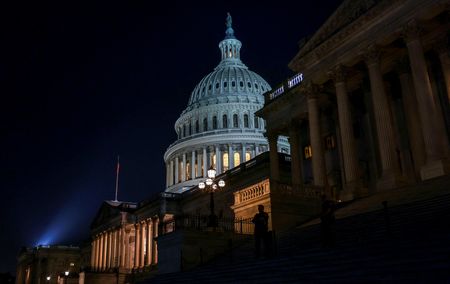By Davide Barbuscia
(Reuters) – Rating agency Fitch on Tuesday downgraded the U.S. government’s top credit rating, a move that drew an angry response from the White House and surprised investors, coming despite the resolution of the debt ceiling crisis two months ago.
Traders’ immediate response was to embark on a safe-haven push out of stocks and into government bonds and the dollar.
Fitch downgraded the United States to AA+ from AAA, citing fiscal deterioration over the next three years and repeated down-the-wire debt ceiling negotiations that threaten the government’s ability to pay its bills.
Fitch had first flagged the possibility of a downgrade in May, then maintained that position in June after the debt ceiling crisis was resolved, saying it intended to finalize the review in the third quarter of this year.
With the downgrade, it becomes the second major rating agency after Standard & Poor’s to strip the United States of its triple-A rating.
Fitch’s move came two months after Democratic President Joe Biden and the Republican-controlled House of Representatives reached a debt ceiling agreement that lifted the government’s $31.4 trillion borrowing limit, ending months of political brinkmanship.
“In Fitch’s view, there has been a steady deterioration in standards of governance over the last 20 years, including on fiscal and debt matters, notwithstanding the June bipartisan agreement to suspend the debt limit until January 2025,” the rating agency said in a statement.
U.S. Treasury Secretary Janet Yellen disagreed with Fitch’s downgrade, in a statement that called it “arbitrary and based on outdated data.”
The White House had a similar view, saying it “strongly disagrees with this decision”.
“It defies reality to downgrade the United States at a moment when President Biden has delivered the strongest recovery of any major economy in the world,” said White House press secretary Karine Jean-Pierre.
REPUTATIONAL DENT
Analysts said the move shows the depth of harm caused to the United States by repeated rounds of contentious debate over the debt ceiling, which pushed the nation to the brink of default in May.
“This basically tells you the U.S. government’s spending is a problem,” said Steven Ricchiuto, U.S. chief economist at Mizuho Securities USA.
Fitch said repeated political standoffs and last-minute resolutions over the debt limit have eroded confidence in fiscal management.
Michael Schulman, chief investment officer at Running Point Capital Advisors said the “U.S. overall will be seen as strong but I think it’s a little chink in our armor.”
“It is a dent against the U.S. reputation and standing,” said Schulman.
Others expressed surprise at the timing, even though Fitch had flagged the possibility.
“I don’t understand how they (Fitch) have worse information now than before the debt ceiling crisis was resolved,” said Wendy Edelberg, director of The Hamilton Project At The Brookings Institution in Washington D.C.
U.S. stock futures dropped in European trading, suggesting the benchmark indices could open sharply lower later on.
The yield on the benchmark U.S. Treasury note fell 2 basis points on the day to 4.03%, while the cost of insuring U.S. sovereign debt against default held largely unchanged on the day, reflecting a sense of calm among investors about the longer-term impact of the downgrade.
“I don’t think you are going to see too many investors, especially those with a long-term investment strategy saying I should sell stocks because Fitch took us from AAA to AA+,” said Jason Ware, chief investment officer at Albion Financial Group.
Investors use credit ratings to assess the risk profile of companies and governments when they raise financing in debt capital markets. Generally, the lower a borrower’s rating, the higher its financing costs.
“This was unexpected, kind of came from left field,” said Keith Lerner, co-chief investment officer at Truist Advisory Services in Atlanta. “As far as the market impact, it’s uncertain right now. The market is at a point where it’s somewhat vulnerable to bad news.”
LIMITED IMPACT
In a previous debt ceiling crisis in 2011, Standard & Poor’s cut the top “AAA” rating by one notch a few days after a debt ceiling deal, citing political polarization and insufficient steps to right the nation’s fiscal outlook. Its rating is still “AA-plus” – its second highest.
After that downgrade, U.S. stocks tumbled and the impact of the rating cut was felt across global stock markets, which were in the throes of the euro zone financial meltdown.
In May, Fitch had placed its “AAA” rating of U.S. sovereign debt on watch for a possible downgrade, citing downside risks, including political brinkmanship and a growing debt burden.
A Moody’s Analytics report from May said a downgrade of Treasury debt would set off a cascade of credit implications and downgrades on the debt of many other institutions.
Other analysts had pointed to risks that another downgrade by a major rating agency could affect investment portfolios that hold top-rated securities.
Raymond James analyst Ed Mills, however, said on Tuesday he did not anticipate markets to react significantly to the news.
“My understanding has been that after the S&P downgrade a lot of these contracts were reworked to say ‘triple-A’ or ‘government-guaranteed’, and so the government guarantee is more important than the Fitch rating,” he said.
Others echoed that view.
“Overall, this announcement is much more likely to be dismissed than have a lasting disruptive impact on the U.S. economy and markets,” Mohamed El-Erian, President at Queens’ College, said in a LinkedIn post.
(Additional reporting by Amanda Cooper in London, Jyoti Narayan in Bengaluru, Lewis Krauskopf and Saeed Azhar in New York; Editing by Megan Davies, Arun Koyyur and Toby Chopra)

